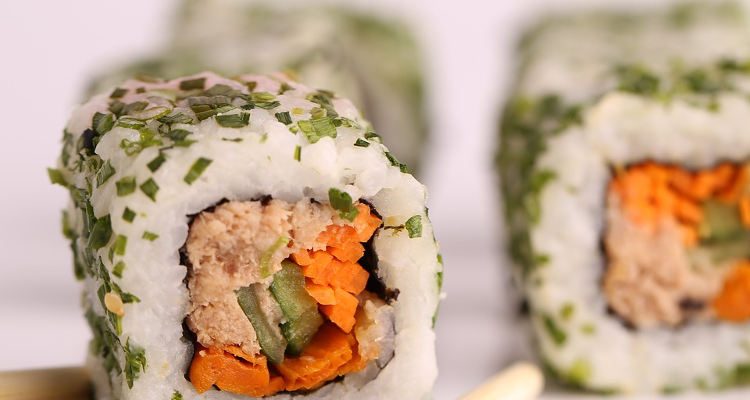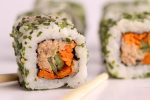
Sushi is a Japanese preparation of vinegared rice and a few other ingredients. Healthy ingredients such as fish, brown rice, and vegetables can be used to make sushi. But is sushi fattening? Well, yes and no.
Sushi made with steamed rice, veggies, and fish is undoubtedly healthy, but the variations in the original recipe which try to make it more appetizing with sauces and fried ingredients make it fattening. Also, there are some health concerns being raised based on the type of raw fish used in sushi and the bacteria, mercury, and parasites that come along with it. Let’s take a closer look.
Can Eating Sushi Make You Fat?
According to a study published in Behavioral and Brain Sciences in 2004, sushi may help in weight loss. But further research is needed to know the effects of sushi consumption on weight and overall health.
Is sushi fattening? Sushi can be made using a variety of ingredients, so it depends on the ingredients used to make it. The ingredients will affect the number of calories sushi contains.
Although the ingredients don’t vary to a great extent, the calories do. Traditional sushi doesn’t include ingredients such as mustard and soy sauces, tempura, fried ingredients, and mayonnaise.
Sushi made with steamed rice, fresh veggies, and lean fish is healthy and may contain around 200 calories per roll. Many people have sushi for weight loss.
According to Katherine Zeratsky (R.D., L.D.), traditional sushi is low in calories. A six-piece sushi roll made with fish and vegetables contains 200 to 250 calories.
If high-calorie ingredients such as fried toppings, creamy sauces, fatty meat, or cheese are used to make sushi, then it can be fattening.
Nutrition Content of Different Types of Sushi
Here are six types of sushi that can cause drastic changes in your weight.
1. Nigiri Sushi
According to Leslie Beck, dietitian and the national director of nutrition at BodyScience Medical, sushi that doesn’t contain added fat, isn’t deep-fried, or loaded with sauces is a healthy, low-calorie food.
Nigiri sushi is fingers of sticky rice topped with a piece of fish or seafood. If squid or scallops are used to make it, then it contains 40 calories. Salmon nigiri sushi contains 50 calories, and eel or sea urchin contains 65 calories.
2. Maki Sushi
It contains sticky rice, fish, and dried seaweed called nori. A single maki sushi contains 45 calories. The calorie count will vary slightly depending on the type of fish used.
3. California Roll
This sushi contains avocado, seaweed, rice, and creamy imitation crab meat. One California roll contains 255 calories consisting of seven grams of fat, 38 grams of carbohydrates, and nine grams of protein.
A California roll equals having two sandwiches filled with crab sticks, an avocado slice, and few pieces of veggies.
4. Shrimp Tempura Roll
This roll contains seaweed, rice, deep-fried shrimp tempura, and other toppings. One shrimp tempura roll contains 508 calories consisting of 64 grams of carbs, 21 grams of fat, and 20 grams of protein. A tempura roll contains more than thrice the calories of an avocado roll.
5. Avocado Roll
An avocado roll contains seaweed, rice, and avocado. It contains around 140 calories consisting of six grams of fat, 28 grams of carbohydrates, and two grams of protein.
6. Spider Roll
These rolls are made with battered, deep-fried soft shell crab and mayonnaise. They contain around 360 calories. A dragon roll and spicy tuna roll contain 520 and 290 calories respectively.
Healthy Ways to Eat Sushi to Avoid Weight Gain
Can sushi make you fat? Sushi can be a part of your healthy weight loss plan if you watch the ingredients that go into it. Or, you can simply make it at home.
1. Opt for homemade sushi
The best way to consume sushi is to have homemade sushi. You can choose your sushi ingredients wisely when making it at home.
You should be aware of the nutritional values of different ingredients to make healthy sushi. Also, you can be sure about the freshness and quality of the fish, as they are served raw in sushi.
2. Avoid fried sushi
Sushi that includes fried ingredients is high in calories. You can have sushi that has raw or steamed ingredients.
You can dine at sushi restaurants as they also offer vegetable rolls. In this way, you can increase the fiber and vitamin intake. Also, avoid too many extra sauces.
3. Have a salad or soup before having sushi
According to Appetite, having a bowl of salad or soup before meals lowers food intake. Doing this will prevent you from consuming excess calories.
4. Have sushi with healthy ingredients
You can opt for sushi made with a small portion of rice and good amounts of veggies and fish. Opt for steamed or grilled fish rather than raw.
Using salmon, trout, and tuna are healthy options for sushi. However, avoid eating tuna often as it is high in mercury.
Use grated ginger instead of wasabi. Ginger has anti-inflammatory properties, and adding it to sushi rolls will ensure that you get its health benefits.
Consuming many sushi rolls means packing on the calories—as much as 1,000 per meal. You can opt for a naruto roll wrapped in cucumber or as sashimi (thinly sliced fish). Naruto and sashimi are both made without rice.
Final Word on Sushi and Weight Loss
Does sushi provide the required amount of protein necessary to lose weight? An individual should consume two portions of fish every week to help maintain a healthy weight.
According to health experts, 140 grams of fish accounts for one serving or portion. Sushi contains around five grams of fish. So, to get the required 140 grams, you will have to eat 28 pieces of sushi. Consuming such large quantities of sushi will increase your calorie intake.
The rice used to make sushi contains sugar and rice vinegar for added flavor. White rice is heavily processed, which deprives it of nutrients. Since it is cooked with salt or soy sauce, you should opt for low-sodium soy sauce.
Pickled vegetables and smoked fish increase the sodium content further. These ingredients load sushi with salt, sugar, and fats.
So, is sushi high in calories or is sushi fattening? It largely depends on the way you make it and the ingredients used. Opt for limited portions of homemade sushi and enjoy it in a guilt-free way.
Sources:
“Can I eat sushi on a diet?” Mayo Clinic, April 8, 2016; http://www.mayoclinic.org/healthy-lifestyle/nutrition-and-healthy-eating/expert-answers/calories-in-sushi/faq-20058179.
Beck, L., “How much sushi can I eat if I want to lose weight?” The Globe and Mail, March 19, 2013; https://www.theglobeandmail.com/life/health-and-fitness/ask-a-health-expert/how-much-sushi-can-i-eat-if-i-want-to-lose-weight/article9230991/.
Vilibert, D., “Is Sushi Good for You or Not?” Redbook, January 13, 2017; http://www.redbookmag.com/body/healthy-eating/a48059/sushi-weight-loss/.













